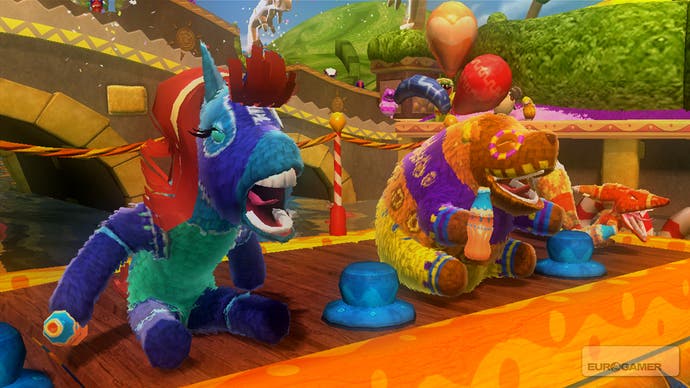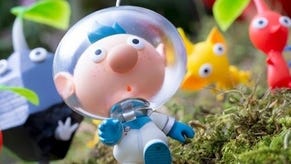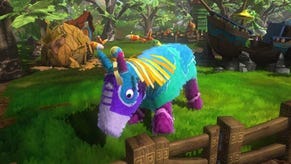Viva Piñata: Party Animals
Party's over.
There's footage of me (in one of those Eurogamer TV Shows Johnny makes when he's not hob-knobbing with Jo Wiley) positively agape with delight at the sight of all my old Viva Piñata friends dancing merrily across Microsoft's E3 mega-screen. This is because I love Viva Piñata. I cuddle it when I go to bed. It was one of the best games of 2006 and I have many happy memories of playing it on cold winter evenings, the warming sights and sounds of a flourishing garden coaxing me further into the night. What the camera failed to capture, however, was what happened next. As the true nature of Party Animals became apparent, my jaw undropped itself and clenched, the smile disappearing from my face in a cascade of furrows and despairing creases. Mini-games. Why not just piss on my face?
That said, we shouldn't be surprised: Viva Pinata was originally conceived as a way of helping the Xbox 360 appeal to kids and families (so much so that poor old Rare had to avoid using the hard disk in case people bought Core Systems), and seems to have failed to do that. Some of the Rare folks blamed the marketing budget going to Gears of War, but VP was a bit complicated anyway - not that it bothered its seemingly unintended beneficiaries, us. And so Party Animals, thrown together by Krome Studios using familiar assets from VP and the (surprisingly watchable) TV show, goes in completely the opposite direction, delivering a mixture of dull foot-races and dull mini-games and handing out Gamerpoints like candy.
There are two things you can do with Party Animals: you can play a selection of randomised mini-games interspersed between foot-races with people sat in your lounge, and you can play a selection of randomised mini-games interspersed between foot-races with people sat in other lounges around the world.

Notice how I used the same words twice in a row to make the paragraph seem longer. Annoying, wasn't it? In which case you will probably also find it annoying that you can't create custom playlists of mini-games, and so encounter the same ones over and over again, not to mention encountering the same elements in multiple games because they're all much of a muchness. Take Messy Mayhem and Ruffian Tumble - both involve Ruffians, both involve whacking things to collect candy, and both are rubbish - or Raisant Stomp and Red Raisant Blast - both about stamping on ants, except one of them has red ants as well. Other mini-games include Tail Time, where you have to pin tails on Zumbugs by positioning the cursor in one place and hitting A occasionally, before moving it to the other side of the screen and hitting A occasionally; and Caramel Apple Gobble, where you press A repeatedly to chomp on an apple, tweaking the analogue stick once per bite so you don't munch on the same part twice. That's it.

One of the better ones is Piñata Mess-terpiece, where you have to run around a circular game area leaving a trail of paint, trying to outdo other players doing the same thing by repeatedly painting over their bits. This is as strategic as Party Animals ever gets, and I would probably have found it more appealing had this exact idea not been done better in Mercury Meltdown on the PSP last year, and probably in about 400 other places at other points in time. Another homage is Who's Left, which is like that Brain Training DS mini-game where people walk into and out of a house and you have to say how many remain inside. I say it's like that - the main difference is that this is astonishingly easy.
If Mess-terpiece is the benchmark, then, not much is done to rival it. Quick Candy Colours is about being first to hit whichever face button corresponds to the colour of the sweetie on-screen. Ruffians Smack Ahoy is Wac-A-Mole with suicide bombes. There's also Short Fuse, where you realise you're paying GBP 40 to play hot potato. And I can't be bothered to list any of the others. There are 40 or more in total. If you played them all in order, you would see them all within an hour or so. But you can't, because it's random, so instead you will have to play it for longer than that.
Doing so will also give you a chance to muse on the strengths and weaknesses of the racing game bits. These involve running around courses that take you across beaches, through towns and treetop villages, over icy bridges and even hurl you over roller-coaster Ruffian railways. There is no question that each environment is gorgeously realised, bursting with happy themes and lively incidental detail, and you will certainly have plenty of time to appreciate these things as you plod through them collecting a mixture of sub-Mario Kart power-ups, keeping an eye out for the telegraphed shortcut that nobody will ever miss more than once. Winning is largely down to these things, and in competitive multiplayer it's pretty important, as your podium position feeds a certain amount of extra points into the results of subsequent mini-games, so a first-placed racer can still be feeling the benefit a few minutes later.

It's hard to say how well that element plays out over the long term, because I was unable to convince my previously willing friends to play more than a couple of full games of Party Animals. Some of them actually left when I proposed another, leaving me to plod through against the AI, which puts up so little resistance (even when you select the option to keep things artificially competitive) that you might as well be playing on your own. Which is a bit of a drawback for programming designed to try and suppress the fact that you are playing on your own.
Anyway, despite my initial reaction to the announcement, I imported this, and popped it into the disc tray hoping against hope that it was more than it seemed. It isn't. It's actually less. There's very little challenge or strategy, and very little imagination has gone into anything besides the visuals, which were done by other people anyway. Xbox 360 wasn't a good system for kids and families before this came out, and nothing's changed. Teach them to play Viva Piñata instead.




